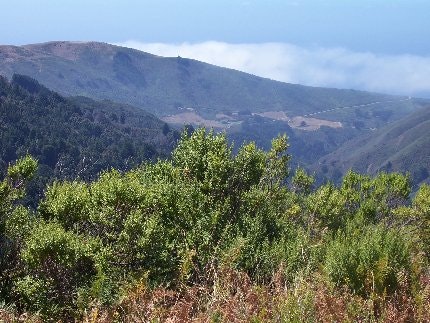Mill Creek Redwood Preserve
MILL CREEK REDWOOD PRESERVE IS CLOSED INDEFINITELY DUE TO ROAD CLOSURE AND DAMAGE FROM THE SOBERANES FIRE.
There is a single trail at Mill Creek that is 2.75 miles in length, one-way. The trail is of moderate difficulty, covering a total elevation change of less than 250 feet. Peak elevation at the end of the trail is 1,986 feet.
Mill Creek History

Mill Creek Redwood Preserve is 1,534 acres of very rugged Big Sur coastal redwood canyon land. The preserve was pieced together with several large properties between 1988 and 2000 for costs totaling $2 million.
The 5.5 mile Mill Creek Trail is an out-and-back route that was completed in 2006; taking 10 years to construct by hand. The craftsmanship is reminiscent of the Civilian Conservation Corps era of trail building during the Great Depression.
The earliest known inhabitants of the preserve are believed to be Esselen. There is very little known about these people as their physical and cultural life ended abruptly after the arrival of Europeans in the latter 18th century.
The preserve and surrounding region remained sparsely settled for almost 100 years until Charles Bixby arrived in 1868 and staked-out a homestead at the mouth of what is now Bixby Creek. He proceeded to introduce cattle and cut tanbark oaks and redwoods for the growing community in Monterey.
In 1906, with his commercial timber depleted, Bixby sold his land to the Monterey Lime Company. Lime was in demand to help re-build San Francisco. The company built a 3-mile aerial tram to haul limestone from Long Ridge to Bixby Landing, a small community that grew up around the Bixby Homestead. Eventually, the exhaustion of local fuel, wood and high operating costs closed the kilns in 1910. The tram remained in business for a time to off and on-load supplies for the community from schooners.
Activity picked up in 1917 when Pacific Grove’s T. A. Work and A. W. Furlong built and operated a logging mill further up the canyon in the preserve. Local Japanese from the peninsula were hired, a camp was constructed, and several steam-donkeys were brought in from San Francisco. Most of the lumber was hoisted up out of the canyon by cables and down what is now Palo Colorado Canyon Road by oxen. Many homes on the peninsula were built with lumber from this operation, which supplied the Work lumber yard near where the Aquarium is now. The mill was closed in 1935 after the marketable timber was cut. Logging was renewed in 1946 when Charles Vander Ploeg built a mill in Beartrap Canyon. This mill was short-lived when a human-caused fire in 1949 destroyed the mill and killed two loggers. Evidence suggests that the redwood logging at that time was for fence posts.
Logging once again found its way into the preserve for a few years in the early ‘60’s. This time the trees were cut in the Turner Creek drainage. This area is in the very upper reach of the canyon and the logging was sporadic and selective. By 1986 the Humboldt County-based Philo Lumber Company owned the property and obtained a state permit to log over a million board feet of redwood. Though intense local opposition was not enough to rescind the permit, the disastrous savings and loan financial crisis played its hand and the property was seized by federal financial regulators. After two years of negotiations the Federal Land Bank sold the property to the Big Sur Land Trust, which then sold it to the District in 1988. The District added three adjacent properties by 2000; one a 125-acre donation from the Barnet Segal Trust.
Drive approximately 10 miles south from Rio Road in Carmel on Highway 1 toward Big Sur. Look for Palo Colorado Canyon Road about ¼ mile past Rocky Point Restaurant. Turn left on Palo Colorado Canyon Road. The entrance to Mill Creek Preserve is located approximately 6.8 miles east of Highway 1. Drive very slowly and carefully. Parking is available on the shoulder of the road adjacent to the entrance to the trail.
PUBLIC ACCESS:
Mill Creek is open to the public via access permit reservation.

